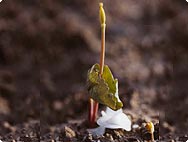
Sanguinaria canadensis L.
Canadian Bloodroot

History
The name Sanguinaria is derived from the Latin word sanguis, which means ’blood‘ and refers to the plant's orange-red juice. The species name canadensis refers to its Canadian origin. The North American tribes used the root as a medication against numerous complaints. They used the juice of the plant to paint their skin, as an insect repellent and to dye objects. American and French dye works also used the plant successfully. At the beginning of the 19th century the root made its way into European trade. It was prescribed in powder or tincture form in small dosages as a sweat-producing agent and as an expectorant in chronic bronchitis. The root of the Sanguinaria is officinal in North America.

Botanical Characteristics
The Canadian bloodroot is a perennial with a woody, creeping rootstock containing a reddish juice. Each year the rootstock produces a single palmate leaf with seven crenate, serrate lobes and a hairless stalk which can be up to 25cm in height and bears a single white flower. The upper surface of the leaf is yellow-green; the lower surface is lighter and has conspicuous orange to violet veins. The flower has 8 to 10 petals and numerous stamens. Two carpels grow together to form a many-seeded capsule that can be between 3cm and 5cm in length.The Canadian bloodroot flowers from March to April.

Habitat
The plant is native to sparse, damp forests of the Atlantic coastal regions of North America, from Canada through Florida to north Mexico.

Preparation
The mother tincture is prepared in accordance with the current Homöopathisches Arzneibuch (HAB) (New Official German Homoeopathic Pharmacopoeia) using the dried underground parts of Sanguinaria canadensis L. that are harvested in the autumn. The homoeopathic dilutions are prepared by means of shaking by hand.
A.Vogel Blog – Natural and Healthy
Inspiration for a healthy life!
HERBAMARE SOUP-ER SOUPS!
DOWNLOAD YOUR FREE RECIPE BOOKLET!
8 healthy, hearty and delicious homemade soups.
Supporting a healthier happier you
“Nature is just about the best thing we’ve got!“
Alfred Vogel's guide to leading a healthy and happy life
Healthy & nutritious dinner ideas
Get new recipes in your inbox every month. Sign up now